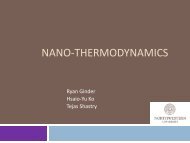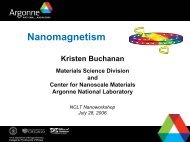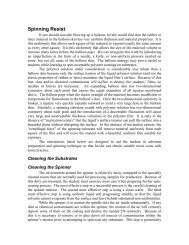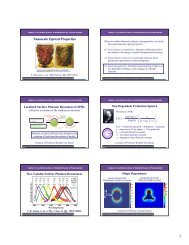A Practical Guide to SPM
A Practical Guide to SPM
A Practical Guide to SPM
You also want an ePaper? Increase the reach of your titles
YUMPU automatically turns print PDFs into web optimized ePapers that Google loves.
16<br />
Scanning Spreading Resistance Microscopy (SSRM)<br />
Scanning spreading resistance microscopy (SSRM) is a patented<br />
(Veeco Instruments) secondary imaging mode derived from contact<br />
AFM that maps variations in majority carrier concentration in<br />
semiconduc<strong>to</strong>r materials. A conductive probe is scanned in contact<br />
mode across the sample, while a DC bias is applied between the tip<br />
and sample. The resulting current between the tip and sample is<br />
measured (referencing it <strong>to</strong> an internal resis<strong>to</strong>r) using a logarithmic<br />
current amplifier, providing a range of 10pA–0.1mA. This yields<br />
a local resistance measurement, which is mapped <strong>to</strong> generate the<br />
SSRM image.<br />
Cantilever mount<br />
Laser<br />
Wollas<strong>to</strong>n wire<br />
Platinum core<br />
Pho<strong>to</strong>detec<strong>to</strong>r<br />
Mirrors<br />
Sample<br />
Scanning Thermal Microscopy<br />
Scanning thermal microscopy (SThM) is a secondary imaging mode<br />
derived from contact AFM that maps two-dimensional temperature<br />
variation across the sample surface. As with many other modes, SThM<br />
allows simultaneous acquisition of <strong>to</strong>pographic data. At the heart of<br />
an SThM system is a thermal probe with a resistive element. A thermal<br />
control unit carries out thermal mapping and control <strong>to</strong> produce<br />
images based on variations in either sample temperature or thermal<br />
conductivity. Common applications include semiconduc<strong>to</strong>r failure<br />
analysis, material distribution in composites, and magne<strong>to</strong>resistive<br />
head characterization.<br />
Figure 5-11. Simultaneous<br />
acquisition of <strong>to</strong>pography and<br />
thermal data. Applied 5V <strong>to</strong><br />
metal trace, constant current<br />
mode (<strong>to</strong>p, right), and constant<br />
temperature mode (bot<strong>to</strong>m, right).<br />
Different types of cantilevers are available for SThM. The cantilever<br />
can be composed of two different metals or it can have a thermal<br />
element made up of two metal wires. The materials of the cantilever<br />
respond differently <strong>to</strong> changes in thermal conductivity, causing the<br />
cantilever <strong>to</strong> deflect. The system uses the changes in cantilever<br />
deflection <strong>to</strong> generate an SThM image — a map of the thermal<br />
conductivity. A <strong>to</strong>pographic image can be generated from changes in<br />
the cantilever’s amplitude of vibration. Thus, <strong>to</strong>pographic information<br />
can be separated from local variations in the sample’s thermal<br />
properties and the two types of images can be collected<br />
simultaneously.<br />
Another type of thermal cantilever uses a Wollas<strong>to</strong>n wire as the probe,<br />
which incorporates a resistive thermal element at the end of the<br />
cantilever. The arms of the cantilever are made of silver wire. The<br />
resistive element at the end, which forms the thermal probe, is made<br />
from platinum or platinum/10% rhodium alloy. This design has the<br />
advantage of being capable of thermal imaging of either sample<br />
temperature or thermal conductivity (Figure 5-11).<br />
V••. Non-imaging Modes
















